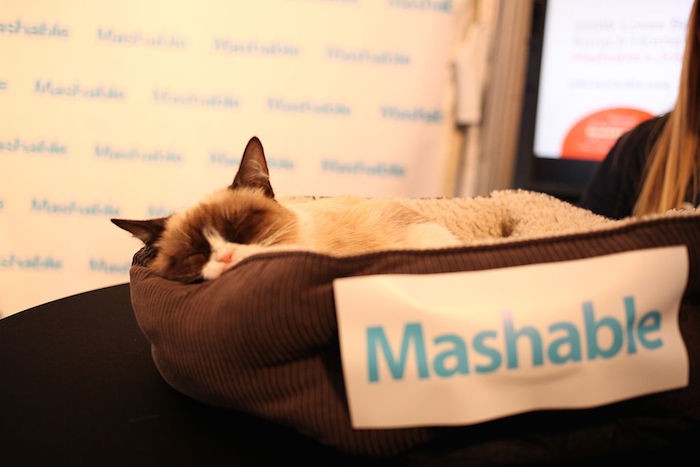
Within minutes of the first reports that a Malaysia Airlines plane had crashed over eastern Ukraine Thursday, Mashable had live coverage up and running. Its real-time news staff in New York was updating the post with videos from the scene and carefully sourced information culled from social media and other outlets; its own social accounts, including its meant-for-breaking-news @MashableLive, were busy pushing out information.
Meanwhile in Ukraine, Christopher J. Miller, a Mashable contributor, was working his sources and providing information to the main Mashable story while also writing his own piece as further developments unfolded. Miller and two editors in New York also cowrote a story highlighting leaked audio from an alleged conversation between pro-Russian rebels and Russian security forces discussing the plane. The breaking news story has been shared more than 30,000 times; Mashable’s continued updating its coverage, including dispatches from Miller filed from the crash site.
.@Mashable newsroom trying to get to the heart of the #MH17 story http://t.co/A0nKUEmeSJ pic.twitter.com/QvkJIyfimK
— Lance Ulanoff (@LanceUlanoff) July 17, 2014
For those who remember the site’s early days — when it was a tech blog covering Web 2.0 startups — the idea of a Mashable correspondent reporting from eastern Ukraine is probably still a bit disorienting. But covering big breaking news this way has quickly become the norm for Mashable — the ongoing conflict between Israel and Hamas, the recent World Cup final, Emmy nominations, and, of course, virtually every major technology announcement.
Executive editor Jim Roberts, who spent 26 years at The New York Times and a short stint at Reuters, was hired last October to lead Mashable’s editorial operation and expand its focus beyond social media and technology. Mashable has an editorial staff of 77, adding nearly 30 of them since Roberts joined the company.
 While Mashable has maintained its traditional coverage areas — Thursday, for instance, it was using its Snapchat account to celebrate World Emoji Day — Roberts has also imbued a sense of old-school focus on covering the news, while still experimenting with how stories are presented, said Brian Ries, Mashable’s real-time news editor.
While Mashable has maintained its traditional coverage areas — Thursday, for instance, it was using its Snapchat account to celebrate World Emoji Day — Roberts has also imbued a sense of old-school focus on covering the news, while still experimenting with how stories are presented, said Brian Ries, Mashable’s real-time news editor.

“You can have the 1,200-word article if you want that — that’s totally fine — but if you think the story can be better told in a series of Vines that are captioned with an explanation, then go with that,” said Ries, who joined Mashable in February from The Daily Beast. “Or if it’s just a video you want to highlight, then do that. It’s been really freeing for me to come in here and be able to play with all different types of content because it feels like you can experiment.”
The Ukraine story is one that Mashable has been paying attention to since the Euromaidan protest movement broke out late last fall. Roberts felt that the familiar east-west tensions playing out in Ukraine would resonate with Mashable’s readers, and as a result it was was one of Mashable’s first major attempts under Roberts’ leadership to take on a significant global story.
“Mashable’s core has really focused on the confluence between technology and digital culture, and those topics are still really essential to us and are really at the heart of what we do,” Roberts told me. “I guess what I’m trying to do is, to the extent that this is possible, is cling to that core, reinforce it as much as possible, and then build around it in a very natural way.”
When the protests began gaining steam, Mashable started writing stories — including a couple by Roberts himself — but they were generally based on social media or other news reports.
But Roberts wanted actual on-the-ground reporting, so he reached out to Miller, who is an editor at the Kyiv Post, an English-language newspaper in Ukraine. Roberts had been following Miller and the paper’s coverage of the growing protest movement on Twitter, and he wanted to know if Miller would write a story for Mashable on how he was covering the protests and how social media was being used as a tool in the Euromaidan movement.
@nycjim Hi Jim. To answer your question in short, yes. Would you follow me so I might be able to DM? Thanks.
— Christopher Miller (@ChristopherJM) December 10, 2013
@nycjim Just a quick note to tell you that the story should be in your inbox. Thanks.
— Christopher Miller (@ChristopherJM) December 11, 2013
“The first story was very much gauged to their audience, which is a very digital-savvy group of readers — it was more focused to that,” Miller told me via phone from Ukraine. “But eventually it just transformed into writing news. Everything from the daily story, if things were big enough and it called for that, to more exclusive pieces.”
Since that first December piece, Miller has written more than 70 stories for Mashable. Other journalists working in Ukraine have also contributed; in the months since then, Mashable has also published stories with datelines from Syria, Egypt, Brazil, and elsewhere.
Roberts and others at Mashable readily admit that, with its relatively small staff, they cannot compete with major global news outlets on every story. “My job is very much about choosing what works for us, because we can’t cover everything and we don’t want to cover everything,” said Louise Roug, Mashable’s global news editor. She previously covered the Iraq war for the Los Angeles Times before becoming foreign editor at The Daily Beast and Newsweek. “That’s a great freedom for us.”
Instead, they say Mashable tries to focus on a wide array of topics — everything from climate change to entertainment — that its audience, which Roberts notes is “younger than most mainstream news organizations,” cares about and is discussing online.
“Now, of course we’ve got this big ambition and we’d like to be covering everything that people are talking about online,” said Mashable managing editor Jonathan Ellis, a former New York Times senior editor for digital platforms who joined Mashable in March. “We’ll get there. But it’s also fun for us to find those areas of focus that we think will make an impact with our audience.”
It’s analogous to the way BuzzFeed started adding more traditional news — and later correspondents stationed overseas — into its mix of cats and listicles. Mashable has no plans to open foreign bureaus, said Roberts, instead relying on well-placed freelancers like Miller and other arrangements like Ukraine Desk, a partnership it launched earlier this year with Vice, Digg, Mother Jones, Quartz, and Breaking News to cover the Ukraine crisis.In March, for instance, the Turkish government blocked Twitter in the country. It was a perfect Mashable story, at the intersection of social media and politics, and the site’s initial story on the block — which quoted social media posts, cited other news reports, and included some original reporting — has been shared nearly 31,000 times.
“We can shine a giant flood light on some things that, despite all their obvious strengths, the BBC or CNN may not get to as quickly,” Roberts said. “Not to say anything bad about CNN or the BBC, but when Turkey shuts down Twitter, it’s the lead story of Mashable. I don’t know of any other news outlet that was leading with Turkey.”
As yet another winter storm was barreling down the East Coast last January, Roberts was reading coverage when he stumbled upon a phrase he had never heard before: the polar vortex. Wanting to know more, Roberts came upon the work of Andrew Freedman, who was then writing for Climate Central, a nonprofit that reports on and researches climate change. Freedman was one of the journalists who pushed the term polar vortex into the public lexicon last winter through his writing and media appearances.
Roberts sent Freedman an email. Within 10 days or so, Roberts had offered Freedman a job. All of a sudden Mashable had a senior climate writer.
“Maybe it was a bit impulsive, but it was one of the best hiring decisions I’ve ever made,” Roberts said. “But that’s the kind of thing that you can do when you’re in a little bit more of a nimble environment.”
Mashable’s staff has grown significantly since Roberts took over; it raised $14 million earlier this year partly to finance the editorial expansion, which includes adding staffers in Australia, London, and Los Angeles.
After his time in traditional media, Roberts said it was refreshing leading a digital-only organization where decisions like that could be made quickly and where the newsroom’s resources to experiment don’t have to compete with those earmarked for print products, still crucial to the bottom lines at major newspapers.“If you’re on one side or the other, it can cause frustrations, so when you’re in a digital-only organization, such as the one I’m working for, you don’t have that conflict — you don’t have that tug of war,” Roberts said. “This is, in a sense, a luxury, but it’s certainly one I enjoy having right now.”
With more than 4 million Twitter followers and 2.6 million Facebook likes, Mashable says it draws about 34 million unique visitors a month. “We just know we’ve got a great team that does all the viral content,” Ries said. “We have a great team that will pull together a funny list of GIFs from the World Cup. And that frees up the other side of the newsroom to go after stories that might not share as well, but are important to be told.”
When Freedman joined Mashable in early February, for instance, he was concerned he wouldn’t be able to write in depth. The Mashable he was familiar with was more about aggregation and shorter stories. So when he received an instant message from Roberts after writing a explanatory story on a major ice storm in Georgia and South Carolina, he was a little concerned.
“Of course, it’s like my first week of work, and I’m terrified that he just showed up on chat,” Freedman said. “His message was, ‘Can you please nerd out a little bit more?’ So any concern that I had that there wasn’t an appetite for geeky weather, climate stuff was put to rest on like day one.”
But striking a balance between, say, writing about a selfie toaster and a weekend-long liveblog on the Ukrainian elections can be a tough task as readers need to change their expectations for what they can expect to see on Mashable. In its marketing material, Mashable defines itself as a site for the “connected generation,” and it is betting that the readers it targets have an interest in more than just viral content and technology coverage.
“Certainly, there will be some folks who see some things on Mashable they won’t have expected to see, and that’s a great thing,” Ellis, Mashable’s managing editor, said. “The whole point of running a great publication is getting them to see things they haven’t seen before.”